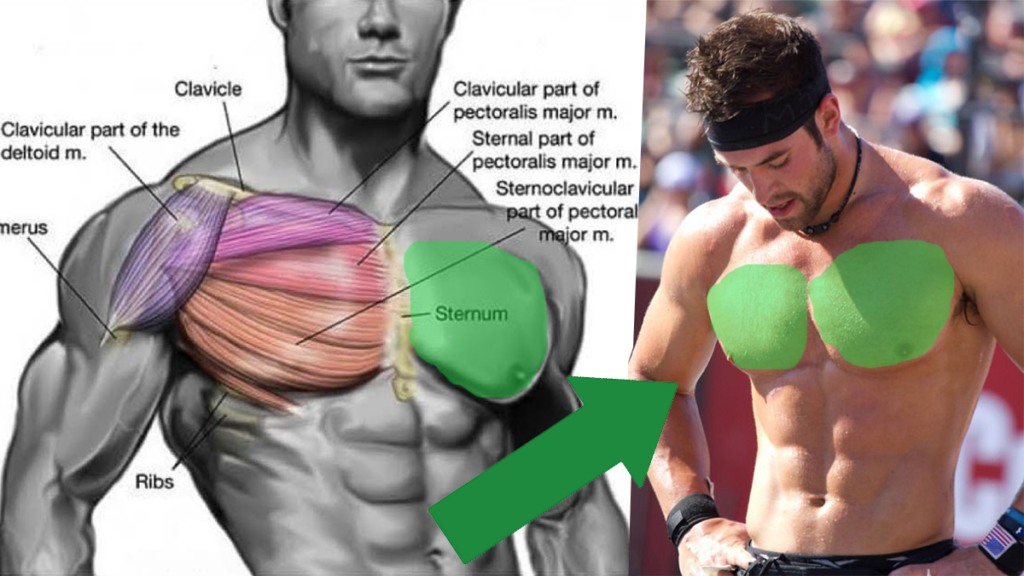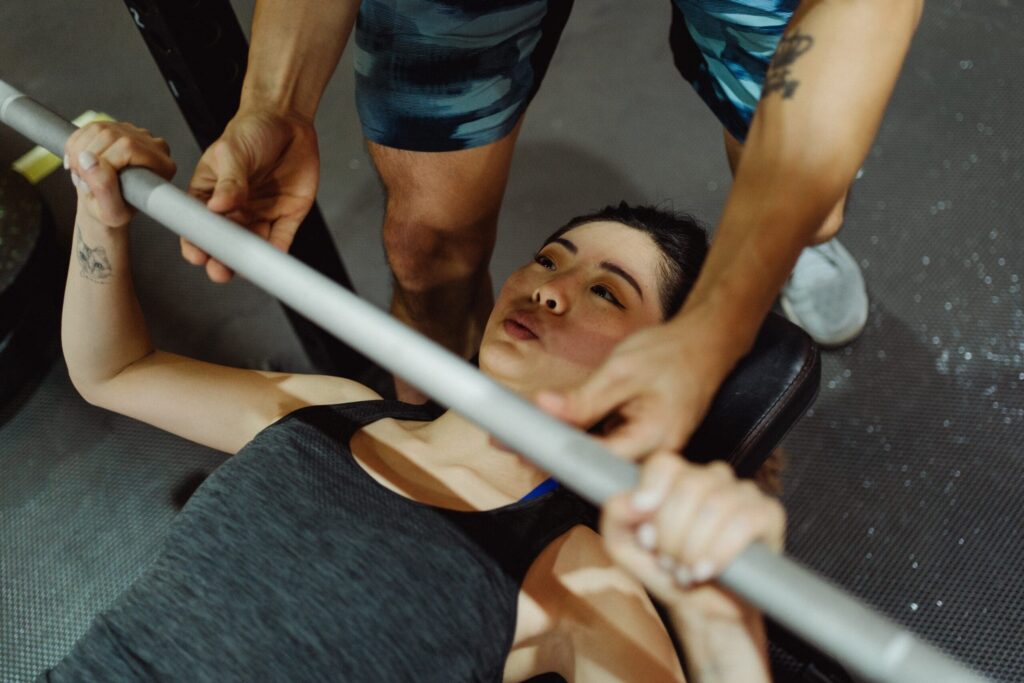When it comes to building a well-rounded chest, the barbell bench press is a staple exercise in virtually every strength training regimen. But not all bench presses are created equal. The flat, declined, and inclined versions of the barbell bench press each target different areas of the chest and involve different muscle activation patterns. Choosing which to prioritise depends on your specific goals, anatomical considerations, and training experience. This article will examine the flat, declined, and inclined bench press variations to help you decide which one is best suited for your training needs.
Table of Contents
Anatomy of the Chest Muscles
Before diving into the specifics of each bench press variation, it is essential to understand the anatomy of the chest muscles.
 Source: Depositphotos / CrossFit Inc
Source: Depositphotos / CrossFit IncThe primary muscle worked during a bench press is the pectoralis major, which has two main parts:
- Clavicular head (upper chest): Positioned along the collarbone, this portion is primarily engaged during exercises that involve pushing at an upward angle, like the inclined bench press.
- Sternal head (middle and lower chest): Located at the centre of the chest, this area is more activated in flat and declined bench press variations.
Supporting muscles include the anterior deltoid (front of the shoulder), triceps brachii, and serratus anterior. Each bench press variation alters the emphasis on these muscles due to changes in the angle and range of motion.
How to Increase Chest Size and Strength
The Flat Barbell Bench Press
Overview
The flat barbell bench press is the classic form of the exercise, where the bench is positioned horizontally. This variation is often considered the gold standard for building overall chest mass and strength. It’s an effective compound exercise that recruits the entire pectoralis major, with a balanced focus on both the upper and lower portions of the chest.
Muscle Activation
Research shows that the flat bench press activates the sternal head of the pectoralis major more evenly than other variations, making it ideal for building thickness across the entire chest . The triceps and anterior deltoids are also heavily involved, particularly during the lockout phase of the movement.
Pros
- Balanced chest development: Targets the entire pectoral muscle equally.
- Strength foundation: The flat bench press allows you to lift heavier weights compared to other variations, making it an excellent exercise for increasing overall upper body strength.
- Simplicity: It is widely used and accessible, making it easy for beginners to learn proper form.
Cons
- Limited upper chest focus: While effective for overall chest development, the flat bench press may not provide enough emphasis on the upper chest, which can lead to an imbalanced physique.
- Shoulder strain: Due to the mechanics of the flat press, some individuals may experience discomfort or injury in the shoulder joint, particularly if proper form is not maintained.
Who Should Do the Flat Bench Press?
The flat bench press is ideal for:
- Beginners looking to build a strong foundation in their chest development.
- Lifters who want to increase overall strength and chest mass.
- Individuals with no pre-existing shoulder issues, as poor technique can exacerbate shoulder problems.
The Declined Barbell Bench Press
Overview
The declined bench press is performed with the bench set at a downward angle, typically between 15 and 30 degrees. This adjustment shifts the emphasis towards the lower portion of the pectoralis major (sternal head) and reduces the involvement of the shoulders. It is often less popular than the flat or inclined variations but can be an effective addition to a well-rounded chest routine.
Muscle Activation
The declined bench press increases activation of the lower chest while minimising shoulder stress . Some research suggests that it also activates the triceps and serratus anterior more effectively than the flat bench press . Due to the decline in angle, the range of motion is shorter, which can allow for heavier lifts.
Pros
- Increased lower chest activation: The decline angle better isolates the lower portion of the chest, which is often neglected in standard routines.
- Reduced shoulder strain: The decline angle decreases the involvement of the shoulder joint, making it a safer option for individuals with shoulder issues.
- Allows heavier lifting: The shortened range of motion can allow for lifting heavier weights, which can promote muscle growth and strength.
Cons
- Limited upper chest engagement: The declined press offers minimal activation of the upper chest, which may lead to an unbalanced appearance if not supplemented with other exercises.
- Uncommon: Many gyms do not have decline benches, making it less accessible.
Who Should Do the Declined Bench Press?
The declined bench press is suitable for:
- Lifters looking to target their lower chest for balanced development.
- Individuals with shoulder discomfort during flat or inclined pressing movements.
- Advanced lifters who want to add variety and intensity to their chest training.
3 Lower Chest Exercises for Better Looking Pecs
The Inclined Barbell Bench Press
Overview
The inclined bench press is performed with the bench set at an upward angle, typically between 30 and 45 degrees. This variation places more emphasis on the upper portion of the pectoralis major (clavicular head), along with increased activation of the anterior deltoids.
Muscle Activation
Research consistently shows that the inclined bench press is superior for targeting the upper chest, making it essential for achieving balanced chest development . However, the inclined angle increases the involvement of the shoulders, which can lead to shoulder strain if not performed correctly.
7 Rare Upper Chest Exercises for Incredible Muscle Gains (Look Good Get Strong)
Pros
- Upper chest development: The inclined bench press is unparalleled when it comes to developing the upper chest, creating a fuller and more balanced chest appearance.
- Shoulder and tricep activation: The increased shoulder involvement can be beneficial for overall upper body strength, engaging the anterior deltoids and triceps more than the flat or declined variations.
- Postural benefits: A well-developed upper chest can improve posture by balancing the chest-to-shoulder ratio, counteracting the effects of sitting for long periods or desk work.
Cons
- Increased shoulder strain: The upward angle places more stress on the shoulder joint, which can lead to discomfort or injury if not executed with proper form.
- Reduced lower chest engagement: The focus on the upper chest diminishes activation in the lower chest, which may result in an imbalanced physique if not paired with other exercises.
Who Should Do the Inclined Bench Press?
The inclined bench press is recommended for:
- Lifters who want to emphasise their upper chest development.
- Individuals looking to improve their upper body strength and posture.
- Those with no history of shoulder issues, as this variation can place significant stress on the shoulder joint.
Comparisons and Key Differences
Now that we’ve covered the individual benefits and drawbacks of each bench press variation, let’s summarise their differences in terms of muscle activation, strength development, and suitability for different goals.

Muscle Activation
- Flat Bench Press: Offers balanced activation of the entire chest, making it ideal for overall chest mass and strength development.
- Declined Bench Press: Targets the lower chest while reducing shoulder involvement, making it effective for lifters focusing on the lower pectorals.
- Inclined Bench Press: Prioritises upper chest development with increased shoulder engagement, making it the go-to for lifters looking to round out their upper body strength.
Strength Development
- Flat Bench Press: Typically allows for the heaviest weights due to the even distribution of muscle activation and range of motion.
- Declined Bench Press: Allows for heavier weights than the flat and inclined versions due to the shortened range of motion and reduced shoulder involvement.
- Inclined Bench Press: Involves more shoulder and tricep activation, making it more challenging to lift as heavy compared to the flat or declined variations.
Suitability for Different Goals
- Overall Chest Development: The flat bench press is the best choice for beginners or those looking to build overall chest strength and mass.
- Lower Chest Focus: The declined bench press is the most effective variation for those looking to build a more defined lower chest or individuals with shoulder discomfort.
- Upper Chest Emphasis: The inclined bench press is unmatched in its ability to build the upper chest, making it a key exercise for those seeking a fuller, more balanced chest appearance.
Structuring Your Workout: Which Should You Prioritise?
For most individuals, a balanced training programme will incorporate all three bench press variations. However, how you structure your workout will depend on your specific goals.
For Balanced Chest Development
- Primary Movement: Start with the flat bench press as your main lift, focusing on heavier weights and lower reps (4-6 reps) to build overall strength.
- Supplementary Movement: Add the inclined bench press to target the upper chest, using moderate weights and higher reps (8-12 reps).
- Accessory Movement: Use the declined bench press or decline dumbbell presses as an accessory exercise for balanced chest development and variety.
 Source: Photo by Ketut Subiyanto on Pexels
Source: Photo by Ketut Subiyanto on PexelsFor Lower Chest Emphasis
- Primary Movement: Begin your workout with the declined bench press, aiming for moderate to heavy weights (6-8 reps) to build lower chest thickness.
- Supplementary Movement: Incorporate the flat bench press with moderate weights to maintain overall chest strength.
- Accessory Movement: Use chest dips or decline push-ups to further isolate the lower chest.
For Upper Chest Focus
- Primary Movement: Prioritise the inclined bench press, starting with heavier weights (6-8 reps) to build the upper chest.
- Supplementary Movement: Follow up with the flat bench press for overall mass and strength.
- Accessory Movement: Finish with dumbbell incline flies or machine incline presses to add volume and further target the upper chest.
9 Perfect Exercises for a More Attractive Lower Chest
Conclusion
Each variation of the barbell bench press—flat, declined, and inclined—serves a unique purpose in a comprehensive chest training programme. The flat bench press offers balanced chest development and strength gains, making it a go-to for beginners and advanced lifters alike. The declined bench press shifts the focus to the lower chest and reduces shoulder strain, making it suitable for lifters with shoulder issues or those seeking lower chest emphasis. Finally, the inclined bench press is essential for developing the upper chest and improving upper body aesthetics.
Incorporating all three variations into your workout routine ensures balanced chest development and reduces the risk of muscle imbalances. However, your specific goals, training experience, and any anatomical considerations should guide the prioritisation of each variation.
Table: Key Takeaways
| Bench Press Variation | Target Area | Key Benefits | Ideal For |
|---|---|---|---|
| Flat Bench Press | Entire chest | Overall mass and strength, balanced development | Beginners, strength-focused lifters |
| Declined Bench Press | Lower chest | Isolates lower chest, reduces shoulder strain | Lifters with shoulder issues, lower chest focus |
| Inclined Bench Press | Upper chest | Builds upper chest, improves posture | Aesthetics-focused lifters, upper chest emphasis |






